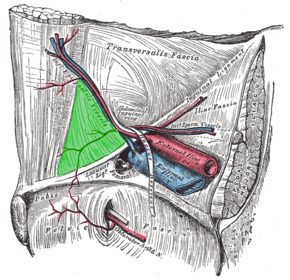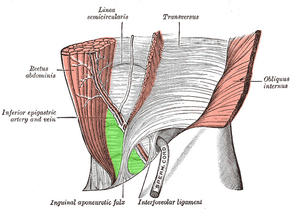Medicine:Inguinal triangle
From HandWiki
Short description: Region of the abdominal wall in humans
| Inguinal triangle | |
|---|---|
 Internal (from posterior to anterior) view of right inguinal area of the male pelvis. Inguinal triangle is labeled in green. The three surrounding structures: inferior epigastric vessels: Run from upper left to center. inguinal ligament: Runs from upper right to bottom left. rectus abdominis muscle: Runs from upper left to bottom left, labeled rectus at upper left. | |
 External view. Inguinal triangle is labeled in green. Borders: inferior epigastric artery and vein: labeled at center left, and run from upper right to bottom center. inguinal ligament: not labeled on diagram, but runs a similar path to the inguinal aponeurotic falx, labeled at bottom. rectus abdominis muscle: runs from upper left to bottom left. | |
| Details | |
| Identifiers | |
| Latin | trigonum inguinale |
| Anatomical terminology | |
In human anatomy, the inguinal triangle is a region of the abdominal wall. It is also known by the eponym Hesselbach's triangle, after Franz Kaspar Hesselbach.
Structure
It is defined by the following structures:
- Medial border: Lateral margin of the rectus sheath.[1][2]
- Superolateral border: Inferior epigastric vessels.[1][2]
- Inferior border: Inguinal ligament.[1][2]
This can be remembered by the mnemonic RIP (Rectus sheath (medial), Inferior epigastric artery (lateral), Poupart's ligament (inguinal ligament, inferior).
Clinical significance
The inguinal triangle contains a depression referred to as the medial inguinal fossa, through which direct inguinal hernias protrude through the abdominal wall.[3]
History
The inguinal triangle is also known as Hesselbach's triangle, after Franz Kaspar Hesselbach.[2]
See also
- Terms for anatomical location
- Inguinal hernia surgery
References
- ↑ 1.0 1.1 1.2 Courtney M. Townsend Jr., MD, R. Daniel Beauchamp, MD, B. Mark Evers, MD and Kenneth L. Mattox, MD (2008). "Ch.43". Sabiston Textbook of Surgery (18th ed.). Elsevier. ISBN 978-1-4160-5233-3.
- ↑ 2.0 2.1 2.2 2.3 Cureton, Elizabeth L.; Ereso, Alexander Q.; Victorino, Gregory P. (2009-01-01), Harken, Alden H.; Moore, Ernest E., eds., "Chapter 55 - Inguinal Hernia" (in en), Abernathy's Surgical Secrets (Sixth Edition) (Philadelphia: Mosby): pp. 269–276, ISBN 978-0-323-05711-0, http://www.sciencedirect.com/science/article/pii/B9780323057110000550, retrieved 2021-01-23
- ↑ MedNote. Red Anatomy. URL: http://www.mednote.co.kr/Rednote/RedAnatom.htm . Accessed December 15, 2005.
 |

